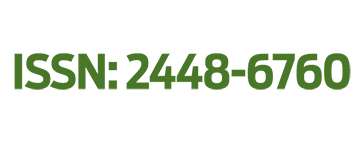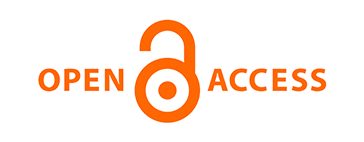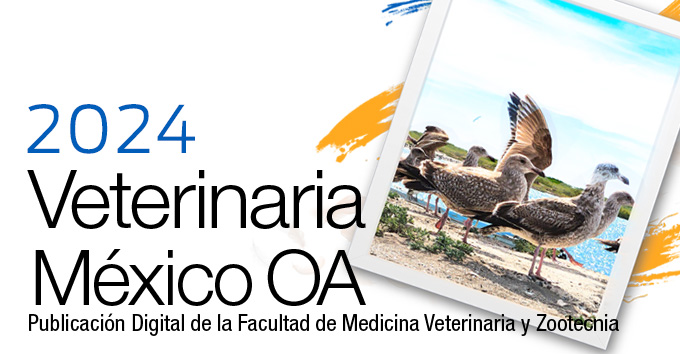Calcium-carbonate and phytoelements to improve egg production in backyard laying hens under heat stress
Contenido principal del artículo
Resumen
The bioavailability (F) of calcium and other nutrients from the gastrointestinal tract in the second and third laying cycle hens and in hens under heat-stress is insufficient to sustain the necessary egg production. The administration of additional amounts of any source of calcium has been shown to be insufficient to meet the demand for calcium. However, improved calcium F has already been achieved in these hens if calcium carbonate is pharmaceutically prepared as patented pellets (FOLAs). Hence, clinical challenges were set to test the FOLA pellets as a form to sustain egg production and eggshell thickness in 180-second and 180-third cycle Bovans-White laying hens, randomly divided into six groups, as follows: cycle-2 control group (GCC2); FOLA-group-capsaicin (GFcC2); FOLA-group-capsaicin-turmeric powder-cinnamon powder (GfexC2); control-group for third cycle hens (GCC3); FOLA-group-capsaicin (GFcC3); FOLA-group-capsaicin-turmeric powder-cinnamon powder (GFexC3). This trial was carried out under moderate heat-stress conditions, and a follow-up was carried out utilizing eye thermographic measurements. The results show that all FOLA-fed hens of the second or third laying cycle presented better laying average and eggshell thickness than the untreated control groups, i.e., GFcC2 128 % higher than GCC2; GfexC2 135 % higher than GCC2; GFcC3 168 % higher than GCC3; and GFexC3 was 173 % higher than GCC3 (P < 0.01 in all comparisons). FOLA pellet formulation, similar to GfexC2, is postulated as a viable natural solution to counter the decreased egg-laying and shell thickness in second and third-cycle hens under moderate heat stress.
Detalles del artículo
Citas
SIAP. Escenario mensual de productos agroalimentarios. Ciudad de México, México: Dirección de Análisis Estratégico. https://www.gob.mx/cms/uploads/attachment/file/759467/Huevo_Agosto_2022.pdf.
FAOSTAT. Statistics Division: Poultry production and products. Food and Agriculture Organization of the United Nations; 2022. https://www.fao.org/poultry-production-products/production/es/.
UNA. Unión Nacional de Avicultores; 2023. https://una.org.mx/mexico-promedio-de-consumo-anual-345-huevos-por-habitante/.
Samanta I, Joardar SN, Das PK. Chapter 14-Biosecurity Strategies for Backyard Poultry: a controlled way for Safe Food Production. In: Holban AM, Grumezescu AM, editors. Food Control and Biosecurity. Academic Press; 2018. p.481–517. (Handbook of Food Bioengineering). doi: 10.1016/B978-0-12-811445-2.00014-3.
Mehdi Y, Létourneau-Montminy MP, Gaucher ML, Chorfi Y, Suresh G, Rouissi T, et al. Use of antibiotics in broiler production: Global impacts and alternatives. Animal Nutrition. june 2018;4(2):170–178. doi: 10.1016/j.aninu.2018.03.002.
Sureshbabu A, Smirnova E, Karthikeyan A, Moniruzzaman M, Kalaiselvi S, Nam K, et al. The impact of curcumin on livestock and poultry animal’s performance and management of insect pests. Frontiers in Veterinary Science. 2023;10:1048067. doi: 10.3389/fvets.2023.1048067.
Melkamu BZ. Phytogenics as feed aditives in poultry production: A review. International Journal of Extensive Research. 2015;3:49-60.
Küçükyılmaz K, Bozkurt M, Herken EN, Çınar M, Çatlı A, Bintaş Y, et al. Effects of Rearing Systems on performance, egg characteristics, and immune response in two layer hen genotype. Asian-Australasian Journal of Animal Science. 2012;25(4):559–568. doi: 10.5713/ajas.2011.11382.
Liu Y, Uyanga VA, Jiao H, Wang X, Zhao J, Zhou Y, Lin H. Effect of feeding strategies on eggshell quality of laying hens during late laying period. Poultry Science. 2022;102(2):102406. doi: 10.1016/j.psj.2022.102406.
Bell DD, Adams CJ. First and second cycle egg production characteristics in commercial table egg flocks. Poultry Science. 1992;71:448−459. doi: 10.3382/ps.0710448.
Roberts J. Factors affecting egg internal quality and egg shell quality in laying hens. The Journal of Poultry Science. 2004;41(3):161–177. doi: 10.2141/jpsa.41.161.
Carrillo L, Bernad M-J, Monroy-Barreto M, Coello CL, Sumano H, Gutiérrez L. Higher bioavailability of calcium in chickens with a novel in-feed pharmaceutical formulation. Frontiers in Veterinary Science. 2020;7:343. doi: 10.3389/fvets.2020.00343.
Gutierrez OL, Alcala Y, Bernard MJ, Sumano LH. Incresed bioavailability of tylosin phosphate as in-feed medication formulation for long-action pellets in broilers chickens. Journal of Applied Poultry Research. 2017;27(1):16−22. doi: 10.3382/japr/pfx035.
Sumano H, Carrillo L, Monroy M, Tapia G, Gutierrez L. Bioavailability of four calcium sources in the second-cycle egg-producing hens. Journal of Applied Poultry Research. 2021;30(1):100–106. doi: 10.1016/j.japr.2020.10.005.
Abdulhakim S, Salam YA, Reza T. Egg quality and safety with an overview of edible coating application for egg preservation. Food Chemistry. 2019(Oct)30;296:29−39. doi: 10.1016/j.foodchem.2019.05.182.
Oluwagbenga EM, Fraley GS. Heat stress and poultry production: a comprehensive review. Poultry Science. 2023;103141. doi: 10.1016/j.psj.2023.103141.
Wasti S, Sah N, Mishra B. Impact of heat stress on poultry health and performances, and potential mitigation strategies. Animals. 2020;10:1–19. doi: 10.3390/ani10081266.
Roberts J. Factors affecting egg internal quality and egg shell quality in laying hens. The Journal of Poultry Science. 2004;41(3):161–177. doi: 10.2141/jpsa.41.161.
Ahmadi F, Rahimi F. Factors affecting quality and quantity of egg production in laying hens: a review. World Applied Sciences Journal. 2011;12(3):72–384.
Kim D-H, Lee K-W. An update on heat stress in laying hens. Worlds Poultry Science Journal. 2023;1–24. doi: 10.1080/00439339.2023.2239769.
Kilic I, Simsek E. The effects of heat stress on egg production and quality of laying hens. Journal of Animal and Veterinary Advances. 2013;12(1). doi: 10.3923/javaa.2013.42.47.
Ali A, Ponnampalam EN, Pushpakumara G, Cottrell JJ, Suleria HAR, Dunshea FR. Cinnamon: A natural feed additive for poultry health and production: a review. Animals. 2021;11(7):2026. doi: 10.3390/ani11072026.
Yang Y, Zhao L, Shao Y, Liao X, Zhang L, Lu YL. Effects of dietary graded levels of cinnamon essential oil and its combination with bamboo leaf flavonoid on immune function, antioxidative ability and intestinal microbiota of broilers. Journal of Integrative Agriculture. 2019;18(9):2123–2132. doi: 10.1016/S20953119(19)62566-9.
Yaqoob A, Razzaq A, Iqbal S, Hassan O, Ishtiaq H, Hussain S, et al. Cinnamon bioactives and their impact on poultry nutrition and meat quality - impact on human health. Acta Scientific Nutritional Health. 2022;6(2):29–38. doi: 10.31080/asnh.2022.06.0990.
Fariba E, Masoumeh Z, Yousefpoor Y, Alipanah H, Safari E, Osanloo M. Anti-inflammatory and anti-nociceptive effects of Cinnamon and Clove essential oils nanogels: an in vivo study. BMC Complementary Medicin and Therapies. 2022;22(1):1−10.
Rao P, Gan S. Cinnamon: a multifaceted medicinal plant. Evidenced-Based Complementary and Alternative Medicine. 2014;2014. doi: 10.1155/2014/642942.
Muhammad D, Dewettinck K. Cinnamon and its derivatives as potential ingredient in functional food-a review. International Journal of Food Properties. 2017;20(Suppl2):2237−2263. doi: 10.1080/10942912.2017.1369102.
Puvača N, Ljubojević D, Spasevski N, Duragić O, Nikolova N, Prodanović R, Bošković J. Effects of turmeric powder (Curcuma longa) in laying hens nutrition: table eggs production, quality and lipid profile. Concepts of Dairy & Veterinary Sciences. 2018;2(1):162−163. doi: 10.32474/cdvs.2018.01.000129.
Khan R, Naz M, Nikousefat M, Selvaggi M, Tufarelli V, Laudadio V. The use of Turmeric (Curcuma longa) in poultry feed. World’s. Poultry Science Journal. 2012;68(1):97–103. doi: 10.1017/S0043933912000104.
Manjunath M, Yashodhar P. Natural antibiotic effect of turmeric in poultry management. International Journal of Poultry and Fisheries Sciences. 2018;2(2):1–2. doi: 10.15226/2578-1898/2/2/00109.
Laganá C, Saldanha ESPB, Sartori JR, Turco PHN, Gonzales E, Luciano RL, et al. Turmeric on poultry production: a review. Agricultural Science. 2019;10(12):1592–1601. doi: 10.4236/as.2019.1012117.
Esatbeyoglu T, Huebbe P, Ernst IMA, Chin D, Wagner AE, Rimbach G. Curcumin-from molecule to biological function. Angewandte Chemie International Edition. 2012;51(22):5308–5332. doi: 10.1002/anie.201107724.
Hewlings S, Kalman D. Curcumin: a review of its effects on human health. Foods. 2017;6(10):92. doi: 10.3390/foods6100092.
Gera M, Sharma N, Ghosh M, Huynh DL, Lee SJ, Min T, et al. Nanoformulations of curcumin: an emerging paradigm for improved remedial application. Oncotarget. 2017;8(39):66680–66698. doi: 10.18632/oncotarget.19164.
Karthikeyan A, Young KN, Moniruzzaman M, Beyene AM, Do K, Kalaiselvi S, et al. Curcumin and its modified formulations on inflammatory bowel disease (IBD): the story so far and future outlook. Pharmaceutics. 2021;13(4):484. doi: 10.3390/pharmaceutics13040484.
Placha I, Gai F, Simonová MP. Natural feed additives in animal nutrition-their potential as functional feed. Frontiers in Veterinary Science. 2022;9: 1062724 doi: 10.3389/978-2-8325-0843-5.
Shehata AA, Yalçın S, Latorre JD, Basiouni S, Attia YA, Abd El-Wahab A, et al. Probiotics, prebiotics, and phytogenic substances for optimizing gut health in poultry. Microorganisms. 2022;10(2):395. doi: 10.3390/microorganisms10020395.
Gutierrez L, Zermeño J, Alcala YY, Sumano H. Higher bioavailability of doxycycline in broiler chickens with a novel in-feed pharmaceutical formulation. Poultry Science. 2017;96(8):2662–2669. doi: 10.3382/ps/pex036.
Murray-Tortarolo GN. Seven decades of climate change across Mexico. Atmósfera. 2021;34(2):217−226. doi: 10.20937/atm.52803.
Weather Spark. El clima en Texcoco, el tiempo por mes, temperatura promedio México. https://es.weatherspark.com/y/6599/Clima-promedio-en-Texcoco-M%C3%A9xico-durante-todo-el-a%C3%B1o#google_vignette.
Bain MM, Dunn IC. Increasing persistency in lay and stabilising egg quality in longer laying cycles. What are the challenges? British Poultry Science. 2016;57(3):330–338. doi: 10.1080/00071668.2016.1161727.
Arulnathan V, Turner I, Bamber N, GrassauerF, Doyon M, Pelletier N. A systematic review of potential productivity, egg quality, and animal welfare implications of extended lay cycles in commercial laying hens in Canada. Poultry Science. 2024;103(4):103475. doi: 10.1016/j.psj.2024.103475.
Foluka AA, Olufemi MA. Turmeric (Curcuma longa): an alternative to antibiotics in poultry nutrition. Translational Animal Science. 2023;1:txad133. doi: 10.1093/tas/txad133.
Ali A, Ponnampalam EN, Pushpakumara G, Cottrell JJ, Suleria HAR, Dunshea FR. Cinnamon: a natural feed additive for poultry health and production-a review. 2021;11(7):2026. doi.10.3390/ani11072026.
Pelicia K, Garcia A, Faitarone G, Silva P, Berto A, Molino B, et al. Calcium and available phosphorus levels for laying hens in the second production cycle. Brazilian Journal of Poultry Science. 2009;11:39−49. doi: 10.1590/S1516635X2009000100007.
Xiao G, Zheng L, Yan X, Gong L, Yang Y, Qui Q, et al. Effects of dietary essential oils supplementation on egg quality, Biochemical Parameters, and Gut Microbiota of Late-Laying Hens. Animals. 2022;12(19):2561. doi: 10.3390/ani12192561.
Zhang L, Gao F, Ge J, Li H, Xia F, Bai H, et al. Potential of aromatic plant-derived essential oils for the control of foodborne bacteria and antibiotic resistance in animal production: a review. Antibiotics. 2022;11(11):1673. doi: 10.3390/antibiotics11111673.
Gopi M, Karthik K, Manjunathachar V, Tamilmahan P, Kesavan M, Dashprakash M, et al. Essential oils as a feed additive in poultry nutrition. Advances in Animal and Veterinary Sciences.2014;2(1):1−7.
O’Sullivan NP. What are the egg traits that further sustainable production? International Poultry Production. 2009;17(6):15–16.
License

Veterinaria México OA por Facultad de Medicina Veterinaria y Zootecnia de la Universidad Nacional Autónoma de México se distribuye bajo una Licencia Creative Commons Atribución 4.0 Internacional.
Basada en una obra en http://www.revistas.unam.mx
- Todos los artículos en Veterinaria México OA se publican bajo una licencia de Creative Commons Reconocimiento 4.0 Unported (CC-BY 4.0). Con esta licencia, los autores retienen el derecho de autor, pero permiten a cualquier usuario compartir, copiar, distribuir, transmitir, adaptar y hacer uso comercial de la obra sin necesidad de proporcionar un permiso adicional, siempre y cuando se otorgue el debido reconocimiento al autor o fuente original.
- Al utilizar esta licencia, los artículos en Veterinaria México OA cubren o exceden todos los requisitos fundacionales e institucionales para ser considerados de Acceso Abierto.
- Los autores no pueden utilizar material protegido por derechos de autor en su artículo a menos que ese material esté también disponible bajo una licencia igualmente generosa.



